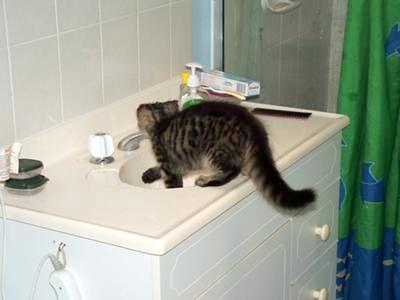by Simon Mouer
(Austin, Texas)

Purebred Turkish Angora Cat - Photo copyright Helmi Flick
When animals mate, their offspring’s traits are set by a giant double-helix DNA molecular complex present in every cell of the body. Our DNA encodes all the physical traits we receive from each parent. At conception the DNA from each parent unwinds in the just fertilized egg, splits into two separate strands, and one strand from each parent join together into a new double helix and becomes the DNA code for the offspring that grows from that particular recombination. This is a physical-chemical process that can be observed under a very high-powered microscope.
The offspring then shares half of each parents DNA code. We can symbolize this by using a double letter to represent each strand of the double helix as follows:
Let one parent’s DNA code be represented by ‘Aa’ where ‘A’ is one strand of the parent’s DNA that unwinds, and ‘a’ is the other strand that unwinds. These strands are not exactly identical, but they are compatible. For the other parent, let ‘Bb’ represent the DNA code, where ‘B’ is one strand of that parent’s DNA that unwinds, and ‘b’ is the other strand that unwinds.
Now when cat A and cat B are mated, the offspring can have one of the following possible DNA re-combinations, where one strand of the A parent combines with one strand of the B parent and forms a new giant double-helix DNA molecular complex.
The possible combinations from this pairing are ‘AB,’ ‘Ab,’ ‘aB,’ and ‘ab. To complicate this simplified model a little, some of the traits encoded in the DNA are dominate, meaning they tend to prevail over a recessive trait when both traits are encoded in the DNA. In other cases, a blend of the two traits will occur.
Now lets take the case where hundreds, if not thousands, of Turkish Angoras were crossbred with Persians (or any other breed) and let loose to breed indiscriminately. Let ‘aa’, ‘Aa’ and ‘AA’ represent variations in the double-helix DNA code of pure Turkish Angora, and ‘bb, ‘Bb’, and ‘BB’ represent any other breed.
Now take the offspring from those original crossbreeds and breed them back and the possible re-combinations are as follows:
If there were only two crossbred parent cats to begin with, we could calculate of the ten possible combinations that the kittens of this pair had a 3 out of 10 (30%) chance of coming out a pure Angora variant, 4 out of 10 (40%) chance of being a cross breed, and a 3 out of 10 (30%) chance of being a variant of the other breed. We can see that it is very possible to for a true-type to spontaneously appear, or a breeder to selectively breed pure Angoras out of cross breeds.
However, the probability of that happening under uncontrolled circumstances is much lower because we also have other breeds and crossbreds (Cc, Dd, Ee, etc, etc.) entering into the gene pool to dilute the occurrence of the Angora strain in the general population of uncontrolled cat reproduction.
The simplified genetic model above is complicated by mutations in the genetic code, which are always occurring. DNA appears to have some corrective mechanisms, and most mutations hurt survival chances. But occasionally mutations stick and are favorable.
Mother nature can also play a harsh role in favoring certain traits, while human-cat interaction generally mitigates the role of mother nature, especially for house-bound cats.
The bottom line in the general uncontrolled genetic pool is that an occasional a true-type Angora will reemerge, if the Angora has been previously introduced in the general population, and many variant Angora-like cross-breeds will emerge.
The Angora is reputedly an old naturally-established breed, But all new breeds result from either mutations, or cross breeds, or combinations thereof. The Somali is a good example of an originally undesirable variant that occasionally appeared in breeding Abyssinians, possibly by crossbreeding with Persians (or maybe even Angoras) with Abyssinians, or perhaps it was a natural variant. Some breeders took a liking to this "undesirable", named it a Somali, and started breeding just for them. Now they are a highly sought after "breed" commanding a high price.
All this just to show how those of us outside the purebred community can indeed occasionally find Angoras popping up from nowhere out of the genetic pool of uncontrolled cats, though most of us are finding variant crossbreeds that may be just as good, or even better.
Simon
Another page by Simon:
The Embodiment of a Turkish Angora Cat
From Why Turkish Angoras pop up in the non-purebred population of cats to Turkish Angora Cat


I love them I have a mail Turkish angora cat white with yellow eyes